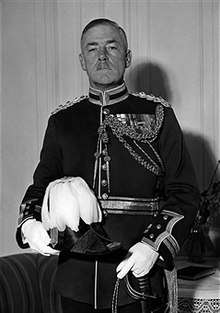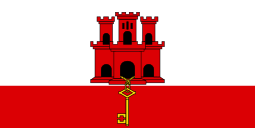Noel Mason-MacFarlane
| Lieutenant General Sir Noel Mason-Macfarlane KCB DSO MC & Two Bars | |
|---|---|
 | |
| Nickname(s) | "Mac" |
| Born |
23 October 1889 Cookham, Berkshire, England |
| Died |
12 August 1953 (aged 63) Twyford, Berkshire, England |
| Allegiance | United Kingdom |
| Service/ | British Army |
| Years of service | 1909–1945 |
| Rank | Lieutenant General |
| Unit | Royal Artillery |
| Commands held |
Allied Control Commission for Italy Governor of Gibraltar 44th (Home Counties) Infantry Division |
| Battles/wars |
First World War Third Anglo-Afghan War Second World War |
| Awards |
Knight Commander of the Order of the Bath Distinguished Service Order Military Cross & Two Bars Mentioned in Despatches Croix de guerre (France) Grand Cross of the Order of Polonia Restituta (Poland) Commander of the Legion of Merit (United States) |
Lieutenant General Sir Frank Noel Mason-MacFarlane KCB DSO MC & Two Bars (23 October 1889 – 12 August 1953) was a senior British Army officer, administrator and politician who served as Governor of Gibraltar during the Second World War.
Early life and military career
Born on 23 October 1889, Mason-MacFarlane was educated at Rugby School and, after attending the Royal Military Academy, Woolwich, was commissioned as a second lieutenant into the Royal Artillery in 1909. He served in the First World War on the Western Front and in Mesopotamia. He was awarded the Military Cross in 1916,[1] a bar to the award in 1918 (gazetted in September) and a second Bar in the same year, awarded while he was attached to the Artillery Headquarters of the 41st Division, the most junior Kitchener's Army division. The citation for the second Bar was published in a supplement to the London Gazette on 2 December 1918, and reads:[2]
For conspicuous gallantry and devotion to duty. While he was engaged on a reconnaissance another officer who was with him was severely wounded by a sniper. He removed him to a place of safety and also brought in a stretcher-bearer who was wounded by the same sniper. He then completed his reconnaissance and returned with valuable and accurate information.
Mason-MacFarlane was also awarded the French Croix de guerre and mentioned in despatches during the First World War.[3]
Between the wars
Between the wars he attended the Staff College, Quetta from 1919 to 1920, and serving on regimental duties, before attending the Imperial Defence College, a prestigious posting for the most promising officers, in 1935.[4] He served as Britain's military attaché to Berlin prior to the Second World War (and proposed the assassination of Adolf Hitler, an offer turned down by his superiors)[5] as well as to Hungary, Austria, Switzerland and Denmark.
Appointed a Companion of the Order of the Bath in the 1939 New Year Honours,[6] Mason-MacFarlane was Director of Military Intelligence with the British Expeditionary Force (BEF) in 1939–40 and during the Battle of Dunkirk was operational commander of "Mac Force," an improvised formation covering the British right flank.[7] For his services, he was awarded the Distinguished Service Order.[8]
Second World War
From July 1940 to March 1941, during the Second World War, Mason-Macfarlane was Second in Command of Gibraltar City and Garrison. This position allowed him to head the Joint Intelligence Centre. He was the head of a joint group of British Army, Royal Navy and Royal Air Force personnel whose role it would be to support General Franco if Spain were to be invaded by Germany. They were to assist the Spanish defence and, if the Spanish did not resist, then they were to create maximum damage.[9]
He briefly served as General Officer Commanding (GOC) of the 44th (Home Counties) Division, a Territorial Army (TA) formation, from April to June 1941, before being appointed Head of the British Military Mission in Moscow, shortly after the German invasion of the Soviet Union (see Operation Barbarossa).[10] He was Governor of Gibraltar from 31 May 1942 to 14 February 1944, and witnessed the air crash there on 4 July 1943, which took the life of his friend the Polish Prime Minister Władysław Sikorski. Advanced to Knight Commander of the Order of the Bath in August 1943,[11] Mason-MacFarlane was appointed a Commander of the Legion of Merit by the United States government that the same month and made a Grand Cross of the Polish Order of Polonia Restituta in October.[12][13] He later served as Chief Commissioner of the Allied Control Commission for Italy in 1944, effectively head of the interim post-war government.[10]
Politics and later life
At the 1945 general election, Mason-Macfarlane was elected as a Labour Member of Parliament for Paddington North, defeating Winston Churchill's close ally, Brendan Bracken. He left Parliament due to ill-health on 22 October 1946.[14]
It was reported in Time magazine on 24 August 1953 that "one of Britain's ablest soldier-administrators" had died of arthritis and complications from a broken leg.[7] Mason-Macfarlane's papers and correspondence are archived in the Imperial War Museum's Department of Documents.
References
- ↑ "No. 29438". The London Gazette (Supplement). 14 January 1916. p. 579.
- ↑ "No. 31043". The London Gazette (Supplement). 2 December 1918. p. 14215.
- ↑ "No. 13350". The Edinburgh Gazette. 12 November 1918. p. 4172.
- ↑ Smart, p. 212
- ↑ Moorhouse, Roger (2007). Killing Hitler: The Plots, the Assassins, and the Dictator Who Cheated Death. Random House. pp. 190–192. ISBN 978-0-553-38255-6.
- ↑ "No. 34585". The London Gazette (Supplement). 2 January 1939. p. 4.
- 1 2 TIME, 24 August 1953.
- ↑ "No. 15725". The Edinburgh Gazette. 16 July 1940. p. 447.
- ↑ Crone, Jim. "Joint Intelligence Centre (use index)". Discover Gibraltar. Archived from the original on 5 September 2013. Retrieved 18 June 2013.
- 1 2 Profile, Generals.dk; accessed 26 March 2016.
- ↑ "No. 36121". The London Gazette (Supplement). 3 August 1943. p. 3529.
- ↑ "No. 36125". The London Gazette (Supplement). 6 August 1943. p. 3579.
- ↑ "No. 36200". The London Gazette (Supplement). 8 October 1943. p. 4441.
- ↑ "No. 37768". The London Gazette. 25 October 1946. p. 5262. He left Parliament by accepting the appointment as Steward and Bailiff of the Manor of Northstead. This is a procedural device to effect resignation from the House of Commons, since members of the House of Commons are not permitted to simply resign their seat, but are disbarred by holding an office of profit under the Crown.
Bibliography
- Mead, Richard (2007). Churchill's Lions: a biographical guide to the key British generals of World War II. Stroud (UK): Spellmount. ISBN 978-1-86227-431-0.
- Smart, Nick (2005). Biographical Dictionary of British Generals of the Second World War. Barnesley: Pen & Sword. ISBN 1844150496.
- Butler, Ewan N. (1972). Mason-Mac: The Life of Lieutenant-General Sir Noel Mason-Macfarlane. London: Macmillan. ISBN 0333114752.
External links
- Hansard 1803–2005: contributions in Parliament by Noel Mason-Macfarlane
- Profile, kcl.ac.uk; accessed 26 March 2016.
| Military offices | ||
|---|---|---|
| Preceded by Arthur Percival |
GOC 44th (Homes Counties) Infantry Division April–June 1941 |
Succeeded by Brian Horrocks |
| Government offices | ||
| Preceded by The Viscount Gort |
Governor of Gibraltar 1942–1944 |
Succeeded by Sir Ralph Eastwood |
| Parliament of the United Kingdom | ||
| Preceded by Brendan Bracken |
Member of Parliament for Paddington North 1945–1946 |
Succeeded by William Field |

